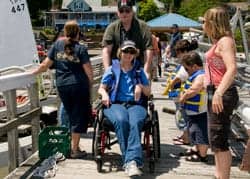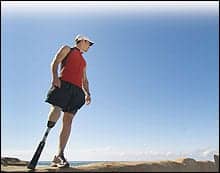 |
A less than healthy American diet combined with a more sedentary lifestyle has given rise to a higher incidence of diabetes in our country, a leading cause of amputation. Factor in the Baby Boomer generation’s effect on our health care system, and strong assumptions can be made that the incidence of amputation is likely to go up over the next 30 years. In doing so, our health care system will need to meet the demands of these more savvy health care consumers by providing a higher standard of care.
The amputee population is a small piece of the health care pie, representing an estimated 5% of the rehab population, but the level of care they need should be measured on a much higher scale. When accepting an amputee to your caseload, you should feel confident that you will deliver the best protocol possible. How is this possible when most therapists simply do not have enough of these patients on their caseload to become highly adept at all the important components of producing an amputee’s gait? Regardless of the size of the caseload, it is important that limb loss rehabilitation start with specific isometric mat exercise that begins to build a foundation of strength to support an upright standing posture. Once the patient graduates to standing activities with the prosthesis, their goals and activities shift dramatically. Focus shifts toward continuing strength building under single leg weight-bearing conditions with some walking. When a patient is able to demonstrate proper ambulatory walking mechanics, objectives should shift toward therapy activities that build a patient’s walking endurance. Following this general pathway is a good start to a positive outcome.

Search Rehab Management’s archives for additional articles on prosthetic solutions.
With the current standard of amputee care, success is all too often measured in how far a patient can walk, instead of how well they walk. Unfortunately, being able to walk 300 feet down a straight hallway with a walker or cane, or being able to navigate a few small environmental barriers, doesn’t demonstrate that an amputee’s gait is fully optimized. Initially, focus should be on the quality of their gait, and as their strength and endurance increase, the quantity of steps they can take will naturally follow.
Rehabilitation of the amputee patient needs to begin postoperative day one and continue until they are back to walking properly. The initial or pre-prosthetic phase is from postop day one until they are ready to receive the prosthesis. This should consist of edema management, incision/wound care, positioning, bed mobility, and transfers. Lower extremity exercises should also begin at this time and include isometric bridging, abduction, and adduction as well as sound limb strengthening and prone extension. The goals of this phase are to prevent or eliminate any contractures, minimize edema, promote residual limb healing and independent functional mobility, and address any strength or flexibility issues that may hinder ambulation. Do not forget to look at the sound limb or to address any issues there. Most importantly, the patient’s initial functional goals are not to single leg hop as far as they can with a walker or to become proficient at single limb balance. This activity will lead to center of balance issues once a prosthesis is introduced.
 |
 |
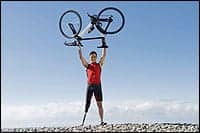 |
Once the patient is released from the acute hospital setting, outpatient therapy should be initiated immediately. The focus of outpatient treatment should be strengthening, flexibility, cardiovascular endurance, center of balance training, and core strengthening. Edema and limb management should also be continued on an outpatient basis and should include soft tissue mobilization, desensitization, and scar mobilization. The focus of evaluation and treatment should be to address all issues that could sabotage the patient and prevent them from becoming a successful ambulator. Things that contribute to decreased success include, but are not limited to: chronic back pain, sound limb dysfunction, arthritis, and postural faults. These issues can generally all be addressed during the pre-prosthetic phase of rehabilitation, prior to receiving the prosthesis.
When the incision is healed and the patient is ready to be fit with the prosthesis, the focus of treatment should shift to prosthetic management and gait training, but the pre-prosthetic strengthening should not be forgotten. This strengthening protocol should continue both at home and in therapy; 10 to 15 minutes of mat exercises at the beginning of each therapy session is important. Prosthetic training is similar to the developmental stages for babies. It should begin with sit to stands and progress to static standing and, when ready, add dynamic activities in standing, then progress to walking. The focus should be equal weight over both lower extremities at all times. There should be a constant awareness of the patient’s center of balance and a constant reminder to keep their center of balance over both feet at all times. Once the patient is able to transfer, stand, and maintain their center of balance, more challenging activities should be added such as: reaching, picking up sound foot, and stepping forward. Once this is achieved, then progress to ambulation while paying special attention to center of balance, step length and width, progression over feet, heel strike and push off, and cadence.
To simplify, think of a trans-tibial patient as a knee patient. All the things needed for successful rehab of a knee patient work for a transtibial patient. Think of a transfemoral patient as a CVA patient and the treatments needed to get a stroke patient to put weight through the hemiparetic side work for a transfemoral patient.
With all the above issues addressed, the patients should be able to return to functional ambulation. In general, the transtibial patient should be able to ambulate with a normal gait with no deviations and return to most activities desired. The average knee disarticulation patient should be able to ambulate without an assistive device with near normal gait. The average transfemoral patient can become a community ambulator with minimal gait deviations and either no assistive device or minimal assistive device.
SELECTING A PROSTHETIST
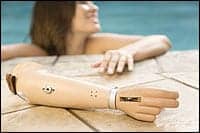 |
Physical therapists are sometimes in the role of referring patients to a prosthetist, but what criteria should be followed in selecting the best choice? Certainly, making this important decision shouldn’t be based solely on choosing a particular company that has a well-branded name in the community. Relying on the credibility that comes with state licensure isn’t a very good way either since fewer than 15 states have orthotist and prosthetist (or O&P) licensure. Certification by a national certifying board (CP, CPO) would be a good way but even this method of finding a qualified prosthetist has been undermined. If you don’t already have a relationship with a good prosthetist, and you need to make a referral, then you should ask a few questions. Has a prospective prosthetist attended an National Commission on Orthotic and Prosthetic Education (NCOPE) accredited school and have they sat for the ABC certification exams? Prosthetists who have attended an NCOPE-accredited school and sat for the three ABC exams have chosen a professional pathway that yields the greatest amount of knowledge base and professionalism for treating limb loss patients.
Beyond a prosthetist’s education pathway, it is also important to choose a prosthetist who is willing to work with you as part of your rehab team. Making a prosthesis is only one part of the process; managing the fit and modifying the alignment as a patient makes progress is the most important role of a prosthetist. As a patient makes progress, measured by their ability to bear more weight through the prosthesis or walk with a less assistive device, their limb will shrink and the prosthetic alignment will change. Socks play an important role in adjusting and maintaining fit, but they can do only so much. When socks fail to maintain a comfortable fit, a prosthetist needs to add pads and make other socket modifications to keep pressure in tolerant areas. When efforts to adjust and maintain the fit of a prosthesis are no longer effective, a replacement is indicated. Why is this so important? When the prosthesis is not comfortable, a patient will shift their weight off the prosthesis and demonstrate a gait deviation in avoidance. Patient discomfort will not allow the therapist to gait train the amputee in the most efficient and effective manner. The initial alignment of a prosthesis can also become quickly obsolete thanks to increased strength, flexibility, and confidence. The most common deviation is when the pylon drifts laterally at midstance, instead of remaining vertical. Another example is when you begin to see the prosthetic foot’s heel compress too much at heel strike because the patient has developed increased quad strength and confidence. When these things happen, it is very important to make prompt alignment changes to the prosthesis so the foot stays properly centered under the patient. Failing to monitor fit and alignment of a prosthesis will prevent patient progress and lead to frustration for the therapist and patient.
WHERE IS TECHNOLOGY GOING?
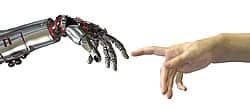 |
The computer age is the best way to describe the trend in prosthetic advances. Numerous prosthetic components, both upper and lower extremity, now require some kind of computer interface to program a prosthesis to each patient’s specific needs. For lower extremity amputations, the microprocessor-controlled knee prosthesis has become the standard for many transfemoral patients (and new, redesigned products are also showing promise for these patients). Myoelectrically controlled upper extremity prosthetics with ever expanding technological advances are giving these patients a broader range of function. A redesigned fully articulating and commercially available bionic hand is claimed to be more durable and more versatile, and is expected to give patients more reliable function than ever before. Instead of upper extremity patients relying on a single pattern of grasp, there are now multiple grasp patterns available in hands with microprocessor controls in each individual finger.
The media always plays a role in shaping perceptions of people with limb loss, but many of their stories leave people expecting more from what is currently available. Targeted muscle reinnervation (TMR), originally developed at the Rehabilitation Institute of Chicago by Todd Kuiken, MD, PhD, is certainly redefining the possibilities for upper extremity amputees, and media coverage of this new technology has been robust. TMR is a way to take the severed nerve from a given segment and innervate a new muscle group. Once the patient goes through a process of healing and therapy to learn to use the newly innervated muscle, a surface electrode can be placed to enable myoelectric signal detection and control. This option provides control of a prosthesis through the more normal neurologic pathways, controlled simply through thought. In essence, a patient thinks about opening the hand and the prosthesis reacts. Nonetheless, this new option for myoelectric prosthetics is in its infancy and is not yet widely available across the United States. As surgeons in our communities accept the challenge of learning this new surgical procedure, patients in these communities will begin to benefit from this new control mechanism. Developments by the Defense Advanced Research Projects Agency (DARPA) program are nearing the end, but the results of its research and development are profound. In the very near future, patients will be given prosthetic options that were once thought of as only science fiction. Through the development of multiple microprocessor control mechanisms, and the potential for multiple site configurations, there may soon be as many as 18 degrees or more of freedom capable from a prosthetic hand.
Mark T. Maguire, CPO, is a prosthetist, and John Boult, CPO, is an orthotist and prosthetist at Advanced Prosthetics Center, Omaha, Neb. For more information, go to www.betterlimbs.com.





